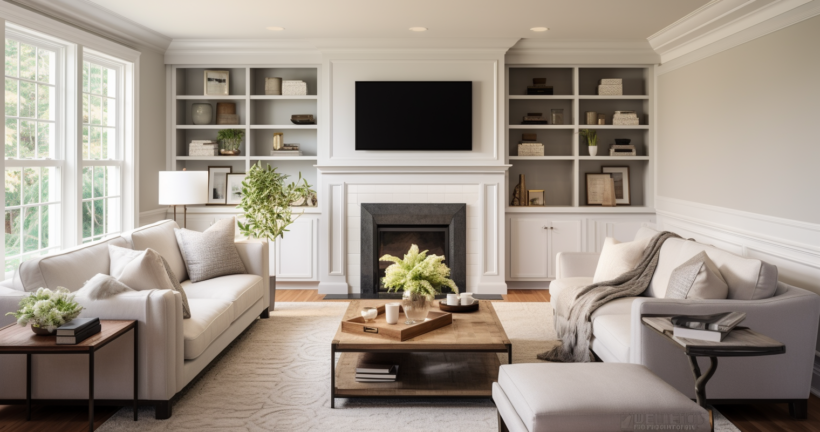In today’s fast-paced world, our homes serve as our sanctuaries. But have you ever stopped to consider How Interior Design Affects Mental Health? Recent studies suggest that the way we design and decorate our living spaces can have profound effects on our mood and overall well-being. From the colors on our walls to the arrangement of furniture, every design choice can either uplift or dampen our spirits. In this article, we’ll delve deep into the intricate relationship between interior design and mental well-being. So, if you’re looking to transform your home into a haven of positivity, read on!
The Psychological Impact of Space

Ever walked into a room and felt an immediate sense of calm? Or entered a cluttered space and felt your anxiety levels spike? It’s not just in your head; it’s the psychological impact of space.
The role of space in our daily lives
Our surroundings play a pivotal role in our daily lives. From the moment we wake up to the moment we drift off to sleep, the spaces we inhabit influence our mood, productivity, and overall well-being.
How different spaces can evoke different emotions?
A well-lit, airy room can evoke feelings of happiness and freedom, while a dark, cramped space might make us feel trapped and anxious. It’s like the rooms have their own personalities, and they’re not afraid to share their mood with us!
The importance of personal space and its impact on mental health
Personal space isn’t just about keeping people out of your bubble. It’s about creating a sanctuary where you can recharge and reflect. A space that’s truly yours. And if you’re looking for inspiration to design such a space, our home decor and interior design ideas might just be the muse you need.
Colors and Their Influence on Mood
| Color | Mood Effect | Applications |
|---|---|---|
| Blue | Calming, Relaxing | Bedrooms, Living Rooms |
| Green | Refreshing, Peaceful | Living Rooms, Home Offices |
| Yellow | Energetic, Uplifting | Kitchens, Workspaces |
| Red | Stimulating, Exciting | Dining Rooms, Creative Spaces |
| Purple | Creative, Luxurious | Home Offices, Creative Spaces |
| Orange | Warm, Invigorating | Living Rooms, Exercise Spaces |
Colors are more than just a visual treat; they’re powerful mood influencers. Ever noticed how you feel calm in a blue room or energized in a red one? That’s the psychology of colors at play.
The psychology of colors
Colors have the power to evoke emotions, memories, and even physical reactions. For instance, green can remind us of nature and bring about a sense of peace, while yellow, being the color of sunshine, can uplift our spirits.
How different colors can affect our mental state
Different colors can have varying effects on our mental state. While soft pastels might soothe and calm, bold and bright shades can energize and invigorate. It’s like having a mood ring but for rooms!
Choosing the right colors for different rooms
When it comes to choosing colors for different rooms, it’s essential to consider the room’s purpose. For instance, blues and greens are perfect for bedrooms, promoting relaxation and sleep. On the other hand, a home office might benefit from energizing yellows or motivating reds. And if you’re keen to dive deeper into the world of color psychology, this article is a must-read.

Importance of Natural Light
Sunlight isn’t just for plants; it’s a mood booster for humans too! The golden rays of the sun don’t just brighten up our rooms; they light up our lives in more ways than one.
The benefits of natural light for mental health
Natural light has been scientifically proven to improve mood, enhance sleep quality, and even boost productivity. It’s Mother Nature’s very own antidepressant. Studies have shown that exposure to natural light during the day can significantly reduce symptoms of depression and anxiety.
Tips for maximizing natural light in your home
To make the most of the sun’s cheerful rays:
- Opt for sheer curtains that allow light to filter through.
- Place mirrors opposite windows to reflect and amplify sunlight.
- Opt for light-colored walls that reflect rather than absorb light.
The role of window placements and treatments
The direction your windows face and the type of treatments you choose can make a world of difference. South-facing windows, for instance, get the most sunlight. As for window treatments, consider light-filtering blinds that offer privacy without blocking out the sun. And if you’re curious about the benefits of LED lighting for those gloomy days, check out this article.
How Interior Design Affects Mental Health
Ever walked into a room and felt an immediate sense of peace? Or felt overwhelmed in a cluttered space? It’s not magic; it’s interior design.
The role of furniture arrangement in promoting positive energy
Furniture arrangement isn’t just about aesthetics; it’s about energy flow. A well-arranged room promotes movement and interaction, while a cluttered space can feel stifling. The ancient art of Feng Shui emphasizes the importance of furniture placement in promoting positive energy and harmony.
Importance of decluttering and its impact on mental well-being
A cluttered space equals a cluttered mind. Decluttering isn’t just about tidying up; it’s about creating a space where you can think clearly and breathe freely. Every item you let go of is a step toward mental clarity and peace.
Incorporating elements of nature into interior design
| Natural Elements | Mental Health Benefits | Examples |
|---|---|---|
| Houseplants | Improved air quality, stress reduction | Succulents, Snake Plant, Pothos |
| Natural Wood | The calming, grounding effect | Wooden furniture, décor |
| Natural Textures | Visual and tactile comfort | Woven textiles, stone accents |
| Nature-Inspired Art | Connection to nature, positive emotions | Landscape paintings, nature photos |
Nature has a calming effect on the mind. Incorporating elements of nature, be it through houseplants, natural wood furniture, or nature-inspired decor, can have a profound impact on mental well-being. It’s like bringing the serenity of the outdoors inside. For a deeper dive into the impact of interior design on mental health, this article is a must-read.
Small Spaces, Big Potential
Ah, the charm of small spaces! They’re cozy, intimate, and… sometimes a tad claustrophobic. But with the right design approach, even the tiniest of spaces can feel like a grand ballroom (well, almost).
Designing for small spaces without compromising mental health
Small doesn’t have to mean restrictive. With thoughtful design, small spaces can be transformed into cozy havens that uplift rather than confine. It’s all about maximizing utility while ensuring the space doesn’t feel cramped.
Multi-functional furniture and its benefits
Enter the heroes of small spaces: multi-functional furniture. Think beds with storage underneath, along with a sintered stone dining table that doubles as work desks or sofas that can be transformed into beds. These pieces not only save space but also reduce clutter, leading to a clearer mind and a happier mood.
Tips for making a small space feel larger and more open
Mirrors, light colors, and strategic furniture placement can work wonders in opening up a space. Vertical storage solutions, like tall bookshelves, can draw the eye upwards, creating an illusion of height. And if you’re on the hunt for the perfect piece to fit your tiny kitchen, our kitchen tables for small spaces might just be the answer.
Balancing Aesthetics and Functionality

Beauty is essential, but so is functionality. Ever bought a stunning chair that’s a nightmare to sit on? That’s a classic case of aesthetics over functionality, and it’s a trap many fall into.
The importance of a functional design for mental well-being
A beautiful space that doesn’t serve its purpose can lead to frustration. Imagine a gorgeous kitchen where you can’t cook or a stunning bedroom where you can’t rest. Functionality ensures that spaces cater to our needs, promoting mental well-being.
Tips for balancing aesthetics and functionality in design
Start with function, then layer on the aesthetics. Ensure the space serves its primary purpose first. Once that’s achieved, you can play with design elements to enhance its beauty. Remember, a room can be both pretty and practical!
Avoiding common design mistakes that can negatively impact mental health
Overcrowding a room, poor lighting, or choosing style over comfort are common pitfalls. These mistakes can make spaces feel chaotic, leading to stress and anxiety. For a deeper dive into how design choices can impact mental health, this article is a treasure trove of insights.
Frequently Asked Questions
How does interior design influence our mood?
Interior design plays a pivotal role in influencing our mood. The colors, lighting, and layout can either elevate our spirits or make us feel confined and stressed.
Can the color of my walls impact my mental health?
Absolutely! Colors have been proven to evoke specific emotions. For instance, blues and greens are calming, while reds can be energizing.
How can I design my home to reduce anxiety?
To reduce anxiety, focus on creating open spaces, using calming colors, and incorporating elements of nature like plants.
Does clutter affect mental health?
Yes, clutter can lead to feelings of stress and overwhelm. A tidy, organized space promotes clarity and peace of mind.
How can light influence our well-being?
Proper lighting is crucial. Natural light boosts mood and productivity, while dim lighting can cause strain and fatigue.
What role does furniture placement play in mental health?
Furniture placement can affect the flow of energy. A well-arranged room promotes positive energy and ease of movement, enhancing well-being.
How can I use interior design to boost my mood during winter?
During winter, focus on warm colors, cozy fabrics, and additional lighting to combat the shorter, darker days and boost mood.
Conclusion
Understanding How Interior Design Affects Mental Health is crucial in today’s world. Our homes are more than just buildings; they’re extensions of ourselves. By making informed design choices, we can create spaces that nurture our mental well-being, offering solace and comfort. Whether you’re redesigning your entire home or just making a few tweaks, remember the profound impact your choices can have on your mental health. Ready to embark on a design journey that prioritizes your well-being? Dive deeper into our articles and transform your space today!
Thank you for reading!
